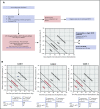How I safely transfuse patients with sickle-cell disease and manage delayed hemolytic transfusion reactions
- PMID: 29724898
- PMCID: PMC6014354
- DOI: 10.1182/blood-2018-02-785964
How I safely transfuse patients with sickle-cell disease and manage delayed hemolytic transfusion reactions
Abstract
Transfusions can be a life-saving treatment of patients with sickle-cell disease (SCD). However, availability of matched units can be limiting because of distinctive blood group polymorphisms in patients of African descent. Development of antibodies against the transfused red blood cells (RBCs), resulting in delayed hemolytic transfusion reactions (DHTRs), can be life-threatening and pose unique challenges for this population with regard to treatment strategies and transfusion management protocols. In cases where the transfused cells and the patient's own RBCs are destroyed, diagnosis of DHTR can be difficult because symptoms may mimic vaso-occlusive crisis, and frequently, antibodies are undetectable. Guidelines are needed for early diagnosis of DHTR because treatment may need to include temporarily withholding any new transfusions to avoid further hemolysis. Also needed are case-control studies to optimally tailor treatments based on the severity of DHTR and develop preventive transfusion strategies for patients at DHTR risk. Here, we will review gaps in knowledge and describe through case studies our recommended approach to prevent alloimmunization and to diagnose and treat symptomatic DHTRs for which complementary mechanistic studies to understand their pathogenesis are sorely needed.
© 2018 by The American Society of Hematology.
Conflict of interest statement
Conflict-of-interest disclosure: The authors declare no competing financial interests.
Figures



References
-
- Adams RJ, McKie VC, Hsu L, et al. . Prevention of a first stroke by transfusions in children with sickle cell anemia and abnormal results on transcranial Doppler ultrasonography. N Engl J Med. 1998;339(1):5-11. - PubMed
-
- Cohen AR, Martin MB, Silber JH, Kim HC, Ohene-Frempong K, Schwartz E. A modified transfusion program for prevention of stroke in sickle cell disease. Blood. 1992;79(7):1657-1661. - PubMed
-
- Oteng-Ntim E, Meeks D, Seed PT, et al. . Adverse maternal and perinatal outcomes in pregnant women with sickle cell disease: systematic review and meta-analysis. Blood. 2015;125(21):3316-3325. - PubMed
-
- Petz LD, Calhoun L, Shulman IA, Johnson C, Herron RM. The sickle cell hemolytic transfusion reaction syndrome. Transfusion. 1997;37(4):382-392. - PubMed
-
- Habibi A, Mekontso-Dessap A, Guillaud C, et al. . Delayed hemolytic transfusion reaction in adult sickle-cell disease: presentations, outcomes, and treatments of 99 referral center episodes. Am J Hematol. 2016;91(10):989-994. - PubMed
Publication types
MeSH terms
Grants and funding
LinkOut - more resources
Full Text Sources
Other Literature Sources
Medical

